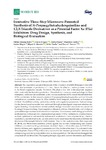Innovative three-step microwave-promoted synthesis of N-propargyltetrahydroquinoline and 1,2,3-triazole derivatives as a potential factor Xa (FXa) inhibitors: drug design, synthesis, and biological evaluation

Use this link to cite
http://hdl.handle.net/2183/24828Collections
- Investigación (FCIE) [1228]
Metadata
Show full item recordTitle
Innovative three-step microwave-promoted synthesis of N-propargyltetrahydroquinoline and 1,2,3-triazole derivatives as a potential factor Xa (FXa) inhibitors: drug design, synthesis, and biological evaluationAuthor(s)
Date
2020-01-23Citation
Santana-Romo, F.; Lagos, C.F.; Duarte, Y.; Castillo, F.; Moglie, Y.; Maestro, M.A.; Charbe, N.; Zacconi, F.C. Innovative Three-Step Microwave-Promoted Synthesis of N-Propargyltetrahydroquinoline and 1,2,3-Triazole Derivatives as a Potential Factor Xa (FXa) Inhibitors: Drug Design, Synthesis, and Biological Evaluation. Molecules 2020, 25, 491.
Abstract
[Abstract]: The coagulation cascade is the process of the conversion of soluble fibrinogen to insoluble fibrin that terminates in production of a clot. Factor Xa (FXa) is a serine protease involved in the blood coagulation cascade. Moreover, FXa plays a vital role in the enzymatic sequence which ends with the thrombus production. Thrombosis is a common causal pathology for three widespread cardiovascular syndromes: acute coronary syndrome (ACS), venous thromboembolism (VTE), and strokes. In this research a series of N-propargyltetrahydroquinoline and 1,2,3-triazole derivatives as a potential factor Xa (FXa) inhibitor were designed, synthesized, and evaluated for their FXa inhibitor activity, cytotoxicity activity and coagulation parameters. Rational design for the desired novel molecules was performed through protein-ligand complexes selection and ligand clustering. The microwave-assisted synthetic strategy of selected compounds was carried out by using Ullmann-Goldberg, N-propargylation, Mannich addition, Friedel-Crafts, and 1,3-dipolar cycloaddition type reactions under microwave irradiation. The microwave methodology proved to be an efficient way to obtain all novel compounds in high yields (73–93%). Furthermore, a thermochemical analysis, optimization and reactivity indexes such as electronic chemical potential (µ), chemical hardness (η), and electrophilicity (ω) were performed to understand the relationship between the structure and the energetic behavior of all the series. Then, in vitro analysis showed that compounds 27, 29–31, and 34 exhibited inhibitory activity against FXa and the corresponding half maximal inhibitory concentration (IC50) values were calculated. Next, a cell viability assay in HEK293 and HepG2 cell lines, and coagulation parameters (anti FXa, Prothrombin time (PT), activated Partial Thromboplastin Time (aPTT)) of the most active novel molecules were performed to determine the corresponding cytotoxicity and possible action on clotting pathways. The obtained results suggest that compounds 27 and 29 inhibited FXa targeting through coagulation factors in the intrinsic and extrinsic pathways. However, compound 34 may target coagulation FXa mainly by the extrinsic and common pathway. Interestingly, the most active compounds in relation to the inhibition activity against FXa and coagulation parameters did not show toxicity at the performed coagulation assay concentrations. Finally, docking studies confirmed the preferential binding mode of N-propargyltetrahydroquinoline and 1,2,3-triazole derivatives inside the active site of FXa.
Keywords
Factor Xa inhibitors
Microwave-assisted synthesis
N-propargyltetrahydroquinoline
1,2,3-triazole
Cell viability assay
Coagulation parameters
Microwave-assisted synthesis
N-propargyltetrahydroquinoline
1,2,3-triazole
Cell viability assay
Coagulation parameters
Editor version
Rights
Atribución 4.0 España






